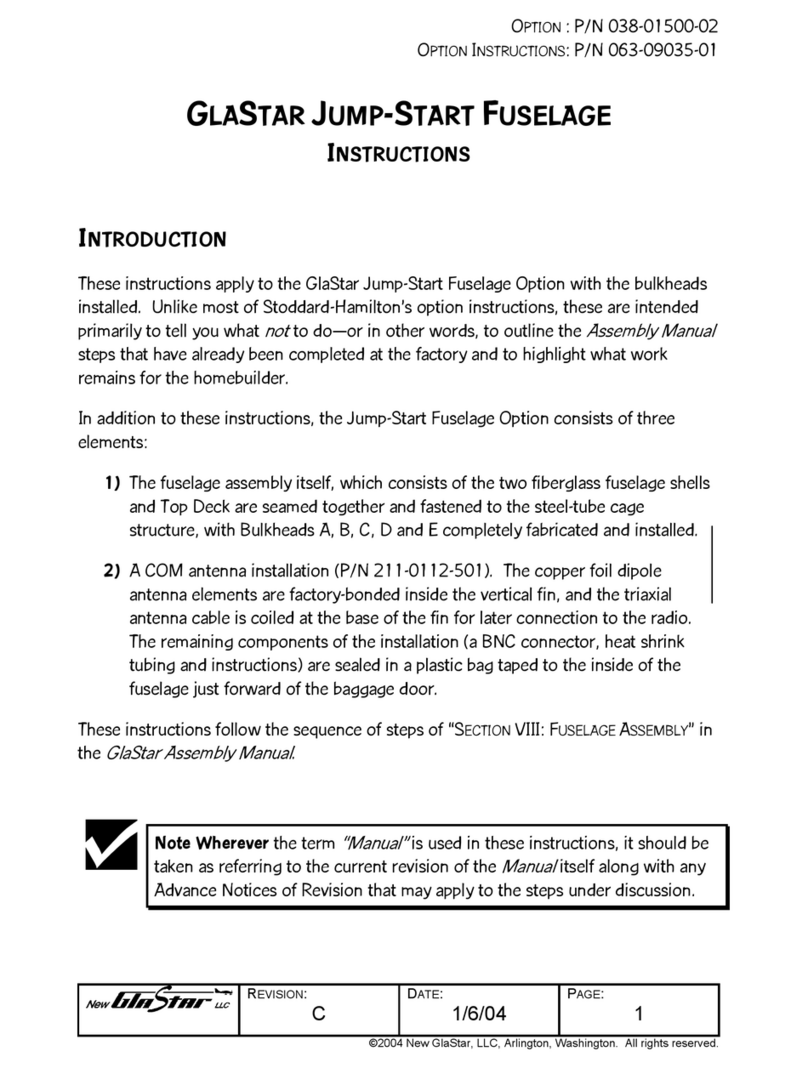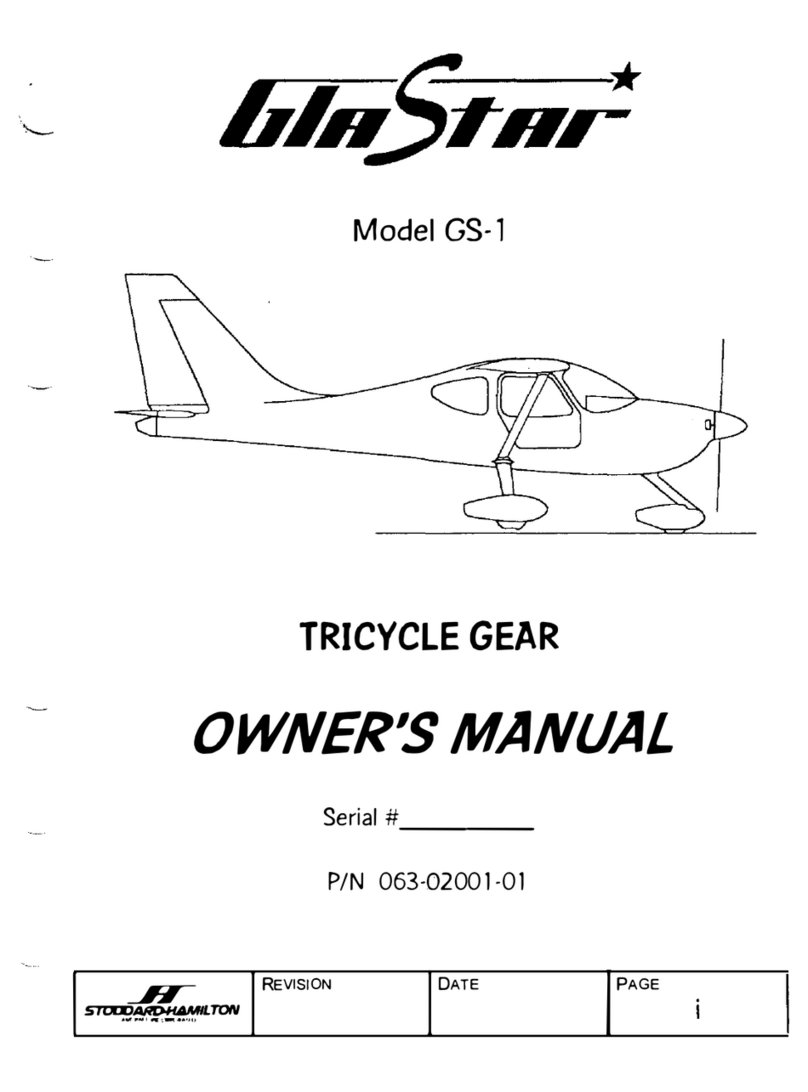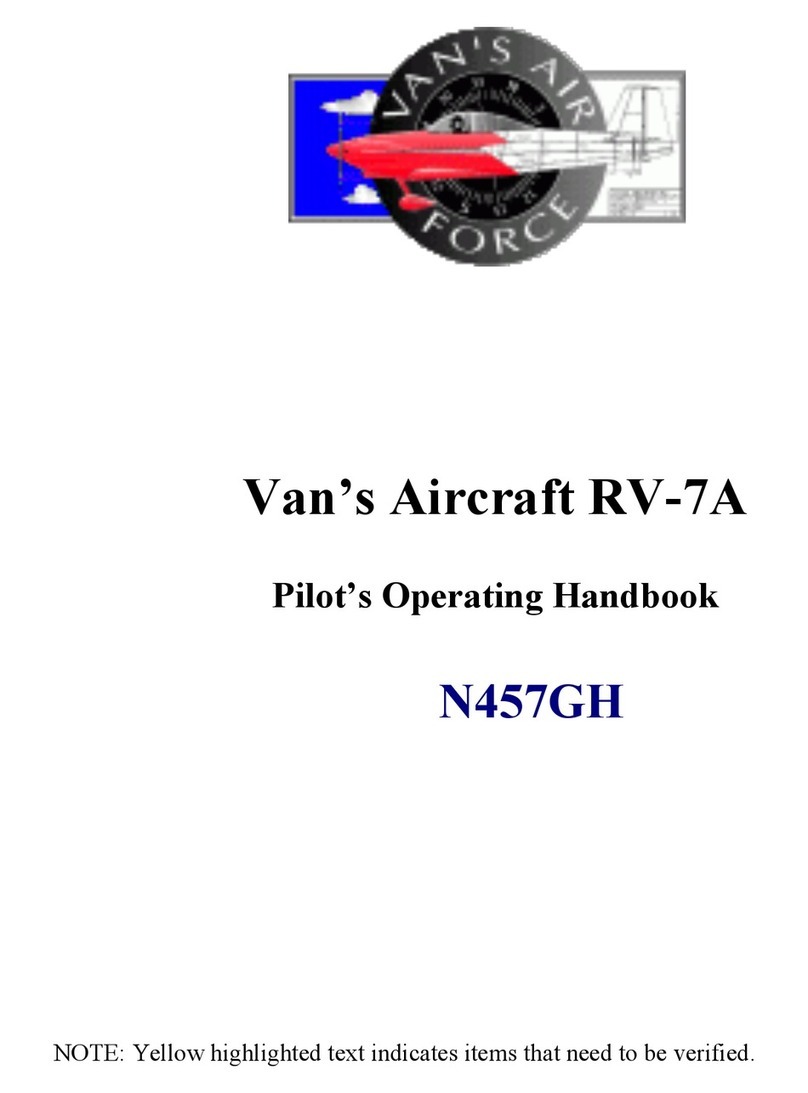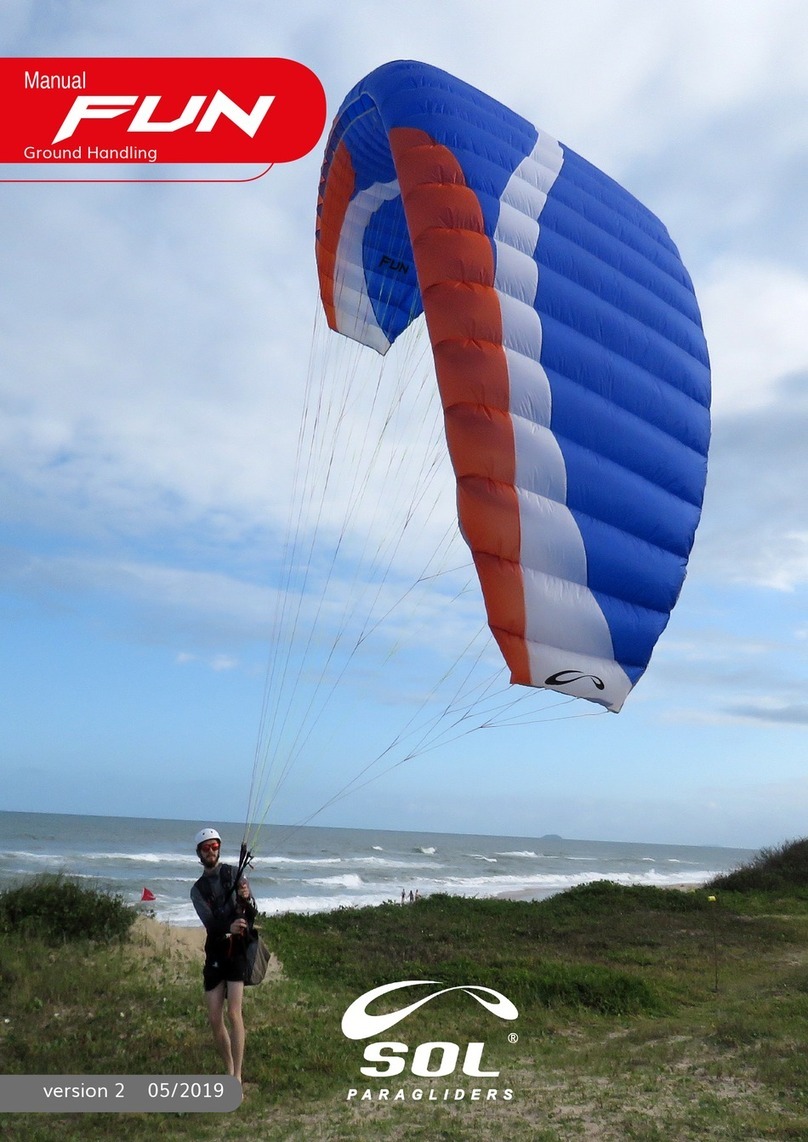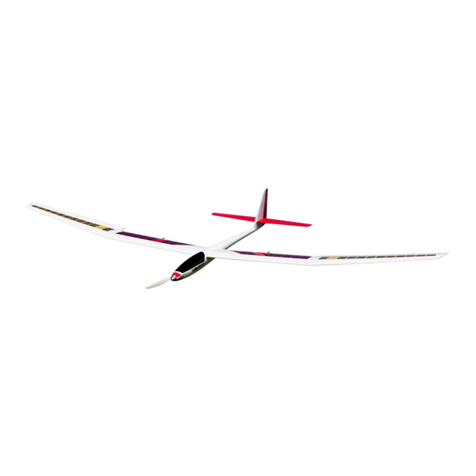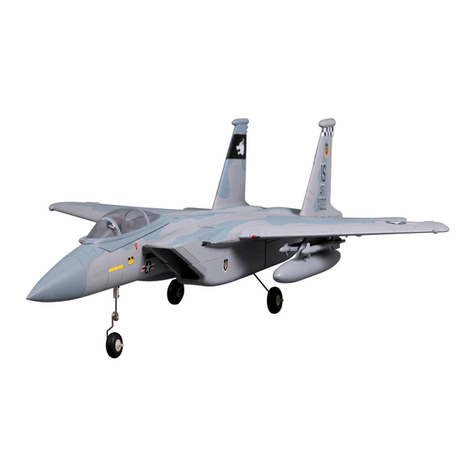Glastar GS-1 User manual

REVISION: DATE: PAGE:
i
Model GS-1
TRICYCLE GEAR
OWNER’S MANUAL
Serial #__________
P/N 063-02001-01

REVISION: DATE: PAGE:
ii
Published by
STODDARD-HAMILTON AIRCRAFT, INC.
18701-58th Avenue NE
Arlington, WA 98223
No part of this manual may be reproduced in any form without the
prior written permission of the publisher.
Copyright ©1998 by
STODDARD-HAMILTON AIRCRAFT, INC.
All Rights Reserved.
Printed in USA

O
WNER
’
S
M
ANUAL
REVISION: DATE: PAGE:
iii
TABLE OF CONTENTS
GENERAL INFORMATION........................................................Section 1
LIMITATIONS.............................................................................Section 2
EMERGENCY PROCEDURES ...................................................Section 3
NORMAL OPERATING PROCEDURES....................................Section 4
WEIGHT AND BALANCE..........................................................Section 5
SYSTEMS DESCRIPTIONS .......................................................Section 6
HANDLING, SERVICING AND MAINTENANCE .....................Section 7
FLIGHT TEST .............................................................................Section 8
SAFETY INFORMATION ...........................................................Section 9

REVISION: DATE: PAGE:
iv
THIS PAGE INTENTIONALLY LEFT BLANK

O
WNER
’
S
M
ANUAL
REVISION: DATE: PAGE:
v
LIST OF REVISIONS
Revision Date Section Page(s)
NO REVISIONS TO DATE

REVISION: DATE: PAGE:
vi
THIS PAGE INTENTIONALLY LEFT BLANK

REVISION: DATE: PAGE:
1
SECTION 1
GENERAL INFORMATION
Table of Contents
Subject: Page:
1-1 INTRODUCTION...........................................................................2
1-2 APPLICABILITY AND PURPOSE .................................................2
1-3 FAA REGULATIONS.....................................................................3
1-4 USE OF THE MANUAL ................................................................4
1-5 REVISIONS ...................................................................................5
1-6 WARNINGS, CAUTIONS AND NOTES.......................................5
1-7 AIRPLANE 3-VIEW.......................................................................6
1-8 SPECIFICATIONS .........................................................................8
1-9 PERFORMANCE DATA............................................................. 10
1-10 SYMBOLS, ABBREVIATIONS AND TERMINOLOGY.............. 12

REVISION: DATE: PAGE:
2
1-1 INTRODUCTION
The sole purpose of this manual is to explain the safe and efficient
operation of your GlaStar aircraft. Section 1 provides basic aircraft
specifications and performance data as well as general information on
the use of the manual. It also contains definitions of symbols,
abbreviations and terminology used throughout the manual.
1-2 APPLICABILITY AND PURPOSE
The information contained in this manual refers to the GlaStar aircraft
(Model GS-1) built according to the
GlaStar Assembly Manual.
Any
homebuilder modifications to the aircraft that deviate from the
Assembly Manual
may alter the applicability of this manual to your
airplane.
This manual is not designed nor can it serve as a substitute for
adequate and competent flight instruction. It is not intended to be a
guide of basic flight instruction or a training manual.
This manual should be read thoroughly and carefully by the owner
and/or operator in order to become familiar with the operation of the
aircraft. It is intended to serve only as a guide under most
circumstances, but cannot take the place of good, sound judgment
during flight operations. Multiple emergencies, adverse weather,
terrain, etc., may require deviation from the recommended procedures.
Furthermore, this
Owner’s Manual
does not provide a discussion of all
possible dangerous situations an owner or operator may encounter.
Flying in itself is not inherently dangerous, but to an even greater

GENERAL INFORMATION
REVISION: DATE: PAGE:
3
extent than any other mode of travel, it is terribly unforgiving of any
carelessness, incapacity or neglect. The builder/pilot is entirely
responsible for the manufacture, inspection, maintenance, test flight
and normal operation of the aircraft. Thorough, careful procedures,
therefore, must be carried out in all these phases.
How well the plane is built, maintained and operated will determine
how safely it performs. Maximum performance and safe operation can
only be achieved by a skilled pilot and a good mechanic. Thorough,
careful construction, continued maintenance and diligent practice
during the early phases of flight familiarization are mandatory.
The performance data presented in this manual are estimates based on
flight tests of Stoddard-Hamilton’s own aircraft. Due to differences in
the engine and propeller installed, quality of workmanship and many
other variables, each airplane will vary somewhat in performance. Do
not assume that your aircraft will have the same performance
characteristics as presented in this manual.
1-3 FAA REGULATIONS
The owner and operator should be familiar with the Federal Aviation
Regulations (FARs) applicable to the operation and maintenance of an
airplane licensed in the experimental amateur-built category and with
FAR Part 91, General Operating and Flight Rules. Further, the airplane
must be operated and maintained in accordance with FAA
Airworthiness Directives that may be issued against powerplants,
propellers and any other parts of the aircraft not manufactured by
Stoddard-Hamilton. Additionally, mandatory service bulletins issued by

REVISION: DATE: PAGE:
4
Stoddard-Hamilton must be complied with.
The Federal Aviation Regulations place the responsibility for
maintenance of this airplane on the owner and operator. All limits,
procedures, safety practices, time limits, servicing and maintenance
requirements contained in this manual are considered mandatory for
continued safe airworthiness and to maintain the airplane in a condition
equal to that of its original construction.
NOTE
References to the Federal Aviation Regulations throughout this
manual refer, of course, to regulations issued by the Federal
Aviation Administration (FAA) in the USA. Owners and
operators of GlaStars in other countries must comply with the
regulations issued by the controlling authorities in their own
countries.
1-4 USE OF THE MANUAL
The
GlaStar
Owner’s Manual
is designed to maintain documents
necessary for the safe and efficient operation of the aircraft. It is
published in loose-leaf form for easy revision updates and in a
convenient size for storage in the airplane. The manual is divided into
nine major sections which are listed in the Table of Contents. Each
section also has its own individual Table of Contents.

GENERAL INFORMATION
REVISION: DATE: PAGE:
5
1-5 REVISIONS
Immediately following the Table of Contents page in the front of the
manual is the “List of Revisions,” which lists all revisions to the
Owner’s
Manual
by the revision letter, date issued, section and page number.
When you receive a revision, remove and discard all the obsolete
pages, and insert the revised pages.
1-6 WARNINGS, CAUTIONS AND NOTES
The following definitions apply to WARNINGS, CAUTIONS and NOTES
used throughout this manual.
WARNING Procedures, practices, etc., which may result in personal
injury or loss of life if not carefully followed.
CAUTION Procedures, practices, etc., which if not strictly observed
may result in damage to or destruction of equipment.
NOTE An operating procedure, condition, etc., which it is considered
essential to emphasize.

REVISION: DATE: PAGE:
6
1-7 AIRPLANE THREE-VIEW

GENERAL INFORMATION
REVISION: DATE: PAGE:
7

REVISION: DATE: PAGE:
8
1-8 SPECIFICATIONS
Wing Span ......................................................................................35.0 ft.
Wings Folded/Tail Removed .................................................... 8.0 ft.
Wing Area.....................................................................................128.0 ft.2
Wing Aspect Ratio ..................................................................................9.6
Fuselage Length:
With Continental IO-240 Engine............................................ 22.3 ft.
Wings Folded (Continental engine)........................................24.5 ft.
With Lycoming Engine............................................................22.8 ft.
Wings Folded (Lycoming engine)...........................................25.0 ft.
Maximum Height.............................................................................. 9.1 ft.
Wheel Base....................................................................................... 5.7 ft.
Wheel Span (track)........................................................................... 7.2 ft.
Cabin Width at Hips.......................................................................44.0 in.
At Shoulders............................................................................ 46.0 in.
Door Width ....................................................................................37.0 in.
Height ......................................................................................31.5 in.
Sill to Ground ..........................................................................33.0 in.
Baggage Space...............................................................................32.0 ft.3
Maximum Gross Weight:.............................................................1,960 lb.
Empty Weight (approx.)...............................................................1,200 lb.
Useful Load (approx.)......................................................................760 lb.

GENERAL INFORMATION
REVISION: DATE: PAGE:
9
Baggage Capacity (max.)................................................................ 250 lb.
Wing Loading, Gross................................................................. 15.3 lb./ft.2
Fuel Capacity (total):
Main Wing Tanks (standard) ................................................. 30.6 gal.
Auxiliary Tanks (optional) ......................................................... 20 gal.
Fuel Capacity (usable):
Main Wing Tanks (standard) ................................................. 27.6 gal.
Auxiliary Tanks (optional) ...................................................... 17.5 gal.
Seats........................................................................................................... 2
Tire Size:
Main Gear................................................................................5.00 ×5
Nose Gear .........................................................................11 ×4.00-5

REVISION: DATE: PAGE:
10
1-9 PERFORMANCE DATA
NOTE
Performance numbers are the actual data from Stoddard-
Hamilton’s prototype GlaStars. The 125 h.p. numbers are for
an aircraft equipped with a Continental IO-240 engine with a
Sensenich 72/57 fixed-pitch propeller. The 160 and 180 h.p.
numbers are for aircraft equipped with Lycoming O-320 and O-
360 engines, respectively, and Hartzell constant-speed
propellers. The performance of a different airplane will vary
depending on engine horsepower, propeller choice, aircraft
weight, airframe construction and pilot ability.
Top Speed (sea level, TAS):
125 h.p. ............................................................... 136 kts./156 m.p.h.
160 h.p. ............................................................... 145 kts./167 m.p.h.
180 h.p. ............................................................... 149 kts./171 m.p.h.
Cruise Speed (75% power @ 8,000 ft., TAS):
125 h.p. ............................................................... 131 kts./151 m.p.h.
160 h.p. ............................................................... 140 kts./161 m.p.h.
180 h.p. ............................................................... 145 kts./167 m.p.h.
Cruise Speed (65% power @ 8,000 ft., TAS):
125 h.p. ............................................................... 122 kts./140 m.p.h.
160 h.p. ............................................................... 133 kts./153 m.p.h.
180 h.p. ............................................................... 138 kts./159 m.p.h.

GENERAL INFORMATION
REVISION: DATE: PAGE:
11
Stall Speeds, Gross:
No Flaps (Vs).............................................................49 kts./56 m.p.h.
Full Flaps (Vso)..........................................................43 kts./49 m.p.h.
Best Rate of Climb Speed (Vy)........................................78 kts./90 m.p.h.
Best Angle of Climb Speed (Vx)......................................65 kts./75 m.p.h.
Best Glide Speed..............................................................70 kts./81 m.p.h.
Maneuvering Speed (Va) .............................................. 98 kts./113 m.p.h.
Maximum Structural Cruising Speed (Vno)...............144 kts./166 m.p.h.
Rate of Climb, Solo:
125 h.p..........................................................................1,300 ft./min.
160 h.p..........................................................................2,075 ft./min.
180 h.p..........................................................................2,150 ft./min.
Rate of Climb, Gross:
125 h.p..........................................................................1,000 ft./min.
160 h.p..........................................................................1,390 ft./min.
180 h.p..........................................................................1,500 ft./min.
Structural Limit Loads, Gross
Positive ....................................................................................... 3.8 Gs
Negative .....................................................................................1.5 Gs
Fuel Consumption at 65% power:
125 h.p............................................................................... 5.8 gal./hr.
160 h.p............................................................................... 6.7 gal./hr.
180 h.p............................................................................... 8.5 gal./hr.

REVISION: DATE: PAGE:
12
Range at 65% power (no wind, VFR reserve):
125 h.p. ................................................................. 520 n.m./598 s.m.
125 h.p. with auxiliary tanks............................... 888n.m./1,021 s.m.
160 h.p. ................................................................. 481 n.m./553 s.m.
160 h.p. with auxiliary tanks................................. 829 n.m./953 s.m.
180 h.p. ................................................................. 380 n.m./437 s.m.
180 h.p. with auxiliary tanks................................. 664 n.m./764 s.m.
Service Ceiling (estimated):
125 h.p. ...............................................................................17,000 ft.
160 h.p. ...............................................................................20,000 ft.
180 h.p. ...............................................................................21,500 ft.
1-10 SYMBOLS, ABBREVIATIONS AND TERMINOLOGY
CAS
— Calibrated Airspeed is the indicated speed of an airplane,
corrected for position and instrument error. Calibrated airspeed is
equal to true airspeed in standard atmosphere at sea level.
KCAS
— Calibrated Airspeed expressed in knots.
GS
— Ground Speed is the speed of an airplane relative to the ground.
IAS
— Indicated Airspeed is the speed of an airplane as shown on the
airspeed indicator when corrected for instrument error. IAS values
published in this manual assume zero instrument error.
KIAS
— Indicated Airspeed expressed in knots.

GENERAL INFORMATION
REVISION: DATE: PAGE:
13
TAS
— True Airspeed is the airspeed of an airplane relative to
undisturbed air, which is the CAS corrected for altitude,
temperature and compressibility.
Va
— Maneuvering Speed is the maximum speed at which the abrupt
application of full available aerodynamic control will not over-stress
the airplane.
Vfe
— Maximum Flap Extended Speed is the highest speed permissible
with wing flaps in a prescribed extended position.
Vne
— Never Exceed Speed is the speed limit that may not be
exceeded at any time.
Vno
— Maximum Structural Cruising Speed is the speed that should
not be exceeded except in smooth air and then only with caution.
Vs
— Stalling Speed or the minimum steady flight speed at which the
airplane can maintain altitude.
Vso
— Stalling Speed or the minimum steady flight speed in the landing
configuration (i.e., full flaps).
Vx
— Best Angle-of-Climb Speed is the airspeed that delivers the
greatest gain of altitude in the shortest possible horizontal distance.
Vy
— Best Rate-of-Climb Speed is the airspeed that delivers the
greatest gain in altitude in the shortest possible time.

REVISION: DATE: PAGE:
14
THIS PAGE INTENTIONALLY LEFT BLANK
Other manuals for GS-1
1
Table of contents
Other Glastar Aircraft manuals
Popular Aircraft manuals by other brands
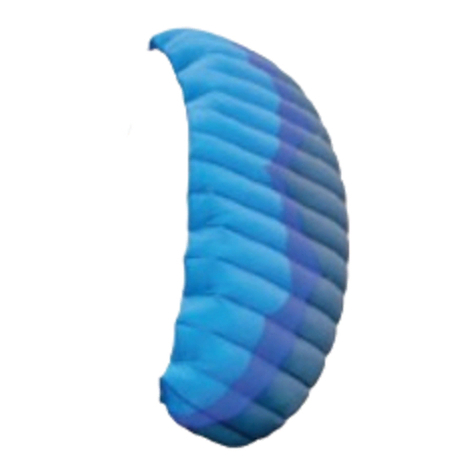
Ozone
Ozone Fazer 3 Pilot's manual

Aeroprakt Ltd.
Aeroprakt Ltd. AEROPRAKT-22LS Pilot operating handbook

MT-Propeller
MT-Propeller MTV-5 Series Operation and installation manual

Cessna
Cessna 182 1973 owner's manual
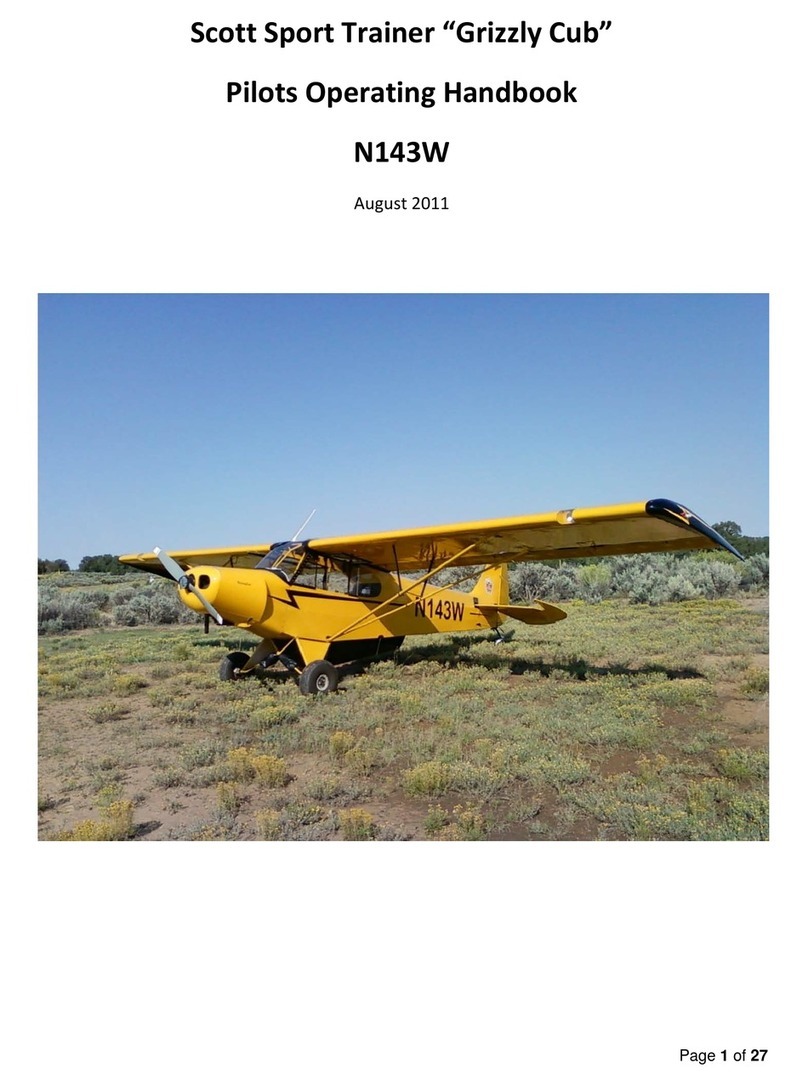
Scott Sport
Scott Sport N143W Pilot operating handbook

HPH
HPH Glasflugel 304S Technical Description, Operating, Maintenance and Repair Manual
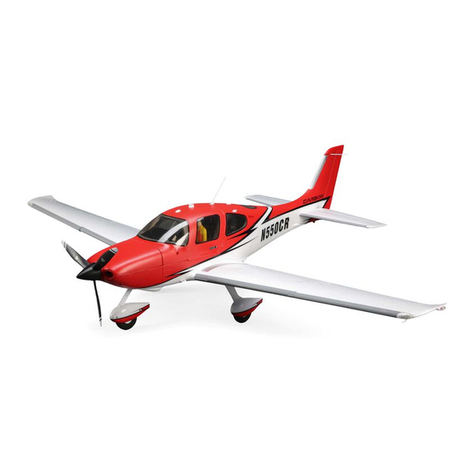
Horizon Hobby
Horizon Hobby Cirrus SR22T instruction manual
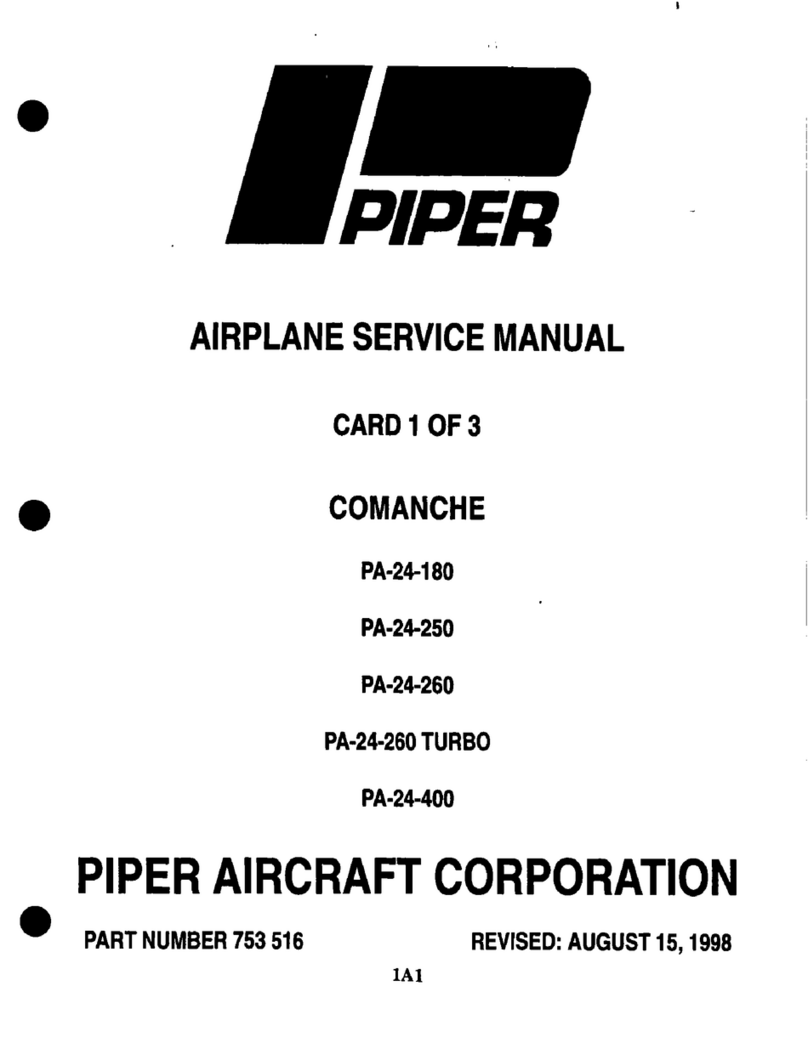
Piper
Piper PA-24-180 Comanche Service manual
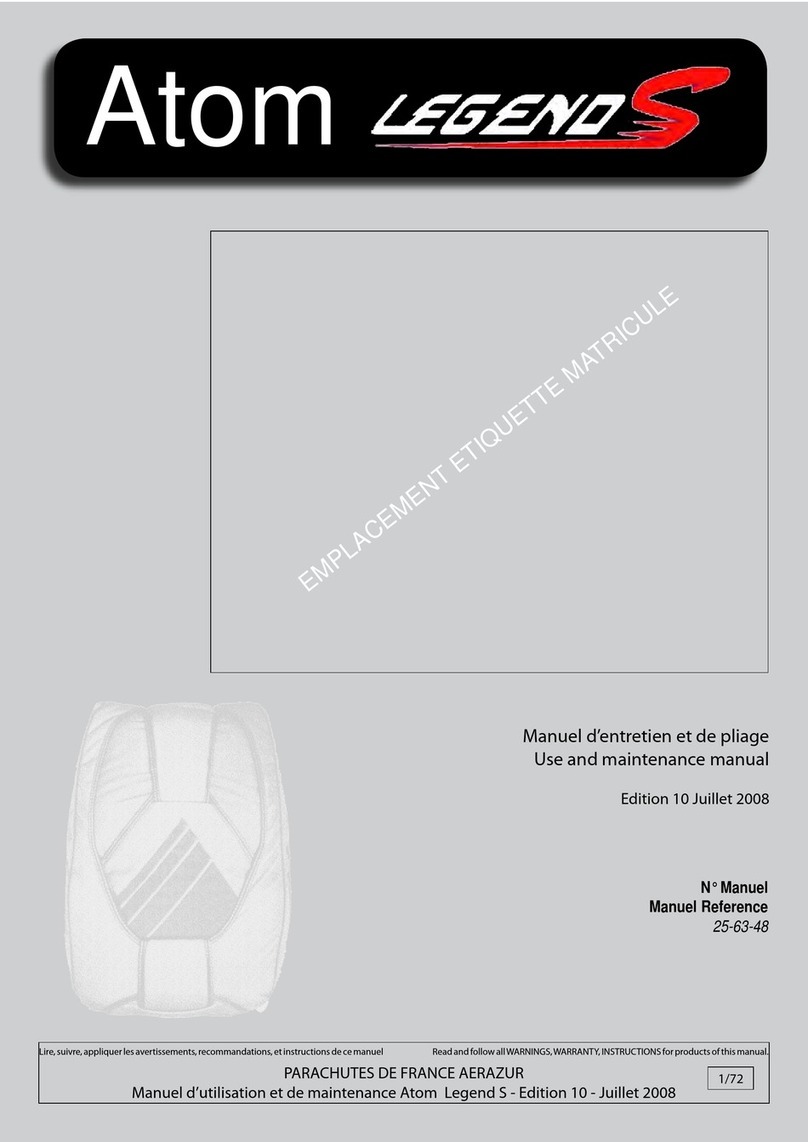
Parachutes de France
Parachutes de France ATOM Legend S Use and maintenance manual
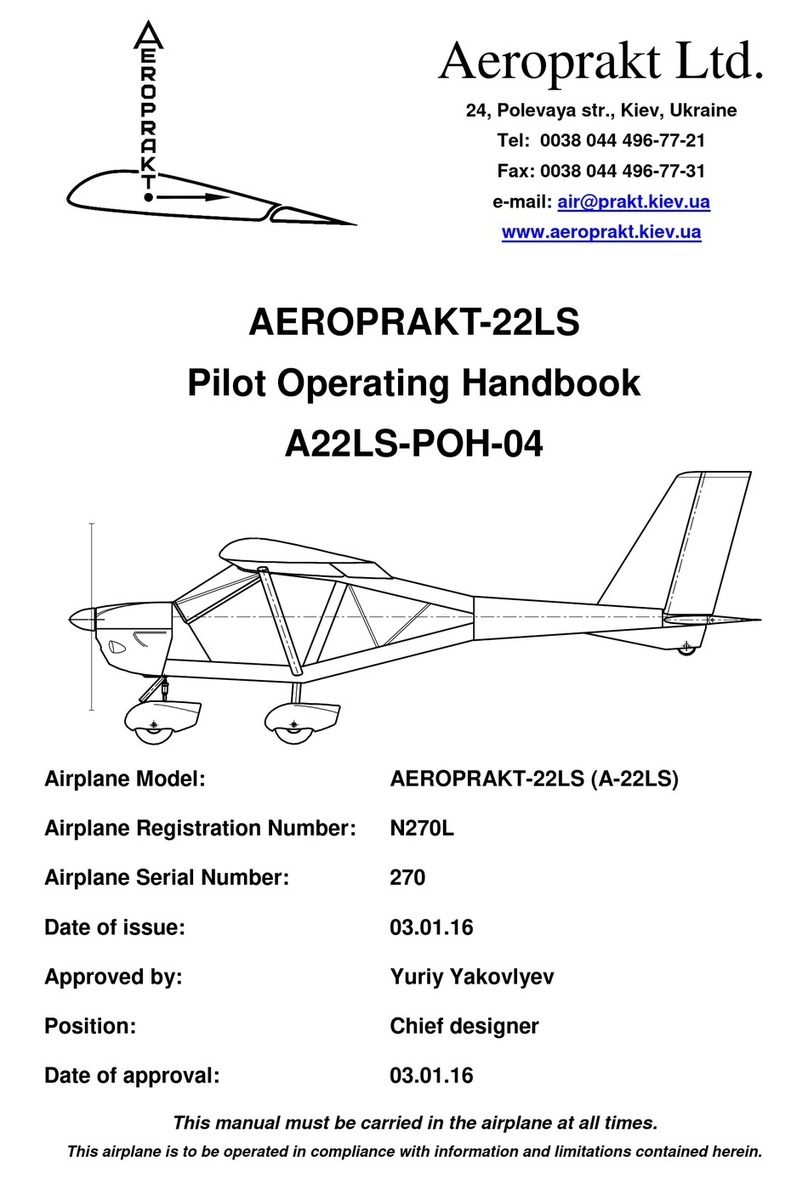
AEROPRAKT
AEROPRAKT A22LS-POH-04 Pilot operating handbook
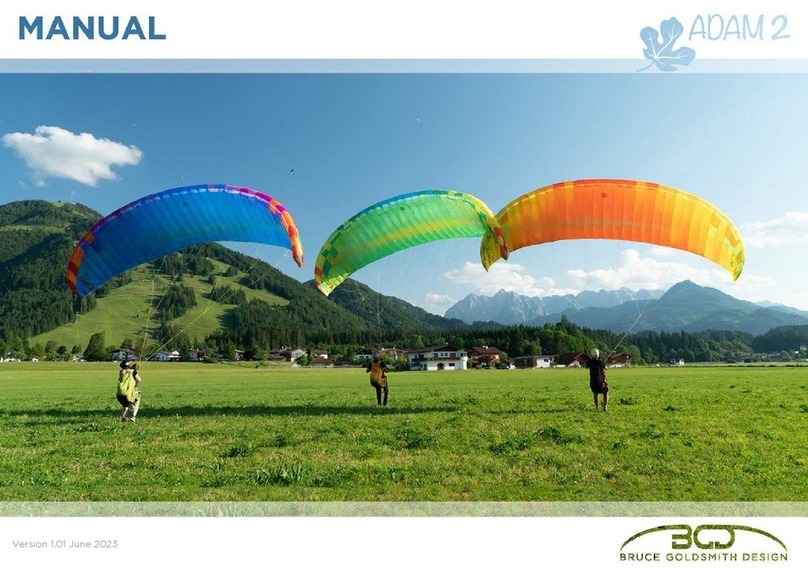
BGD
BGD Adam 2 manual
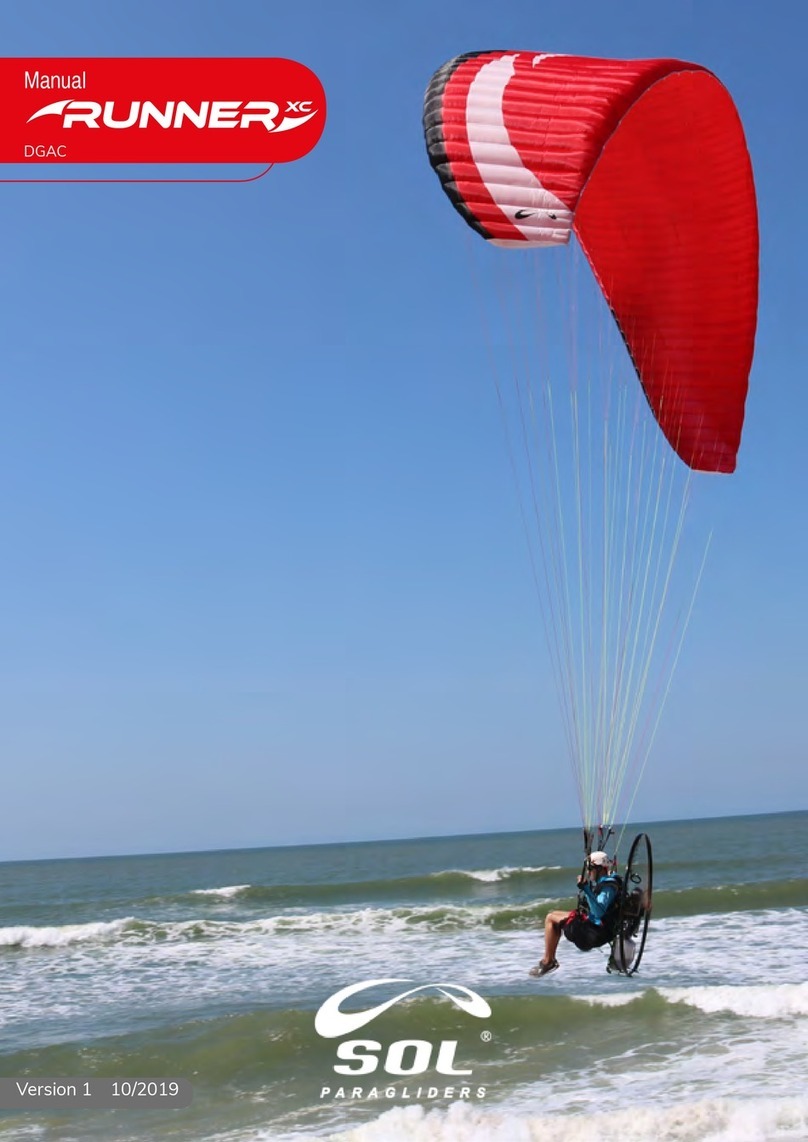
SOL paragliders
SOL paragliders Runner XC Series manual
